September is almost past us, but before we turn the calendar, I wanted to highlight a movement that has been going on this month on Instagram. The hashtag #secondhandseptember was started by Oxfam, a charity in the UK – currently, there are over 46,000 posts under this hashtag. Oxfam operates a chain of thrift stores, or charity shops as they’re called in the UK. The hashtag emphasizes the importance of purchasing secondhand clothes as opposed to new items. This month, Oxfam encouraged people to take a pledge not to buy any new clothing for the whole month of September.
Over the past few years, there has been a definite shift in the online perception of thrift stores and thrifting. Take a quick look at this information from Google Trends, for example:

From 2014-2017, the searches for “thrifting” on Youtube remained relatively constant. But since fall 2017 there has been a pronounced rise in searches, including a prominent spike in July. Correct me if I’m wrong, but in my experience, shopping secondhand used to carry quite a negative connotation – it was considered low-class; a sign of poverty. I remember that in the mid to late 2000s, brand names were all the rage. The way to be “cool” was to wear the biggest brand name from the most expensive store (at the time, the trendy brands included Abercrombie & Fitch, Hollister, and slightly cheaper versions such as Aeropostale and American Eagle). When I was quite young, nearly all my clothes were hand-me-downs or thrift store finds, but as I went through middle school and high school, my mom and I would shop exclusively on the sale rack. Therefore, I was sufficiently “cool.”
I believe the shift is largely a reaction against fast fashion. As a teen (this was maybe around 2012) I checked out a book from the library called “Overdressed: The Shockingly High Cost of Cheap Fashion” by Elizabeth Cline. It was quite an eye-opener – I had already been aware of sweatshops and dangerous working conditions, but at the time, I really didn’t know what to do about it. Even today I’m not perfect, and most of the time I can’t afford clothes made in North America or Europe, but I’m trying to do better by thrifting. Anyways, with books like this, and documentaries such as The True Cost (2015), consumers are considering ethical issues more than ever before. To some extent, brands have responded to this by trying to produce clothing more ethically. However, many are rejecting these brands entirely, in favour of shopping secondhand.
Furthermore, consumers are also more conscious of the environmental impact of their shopping. The textile industry is second only to the oil industry in terms of how much pollution it produces. Therefore, a great way to reduce the pollution is to simply buy clothing that has already been made, rather than purchasing brand new clothing and driving the demand for fast fashion. Thrifting is a great way to be more eco-friendly without breaking your budget.
With all that being said, I’ve been actively shopping at thrift shops this whole month and have not bought any brand-new clothing (yay!) I found that you can get a lot of high quality items and well-known brands at thrift stores. Moreover, even though some stores have high prices, they have sales regularly and you can save even more money that way! Let’s check out some of the things I got!

First of all, I bought this sweater on Friday morning at Salvation Army. They were having an amazing sale: blazers, sweaters, shirts, blouses, and pants were all 50% off! Side note: Salvation Army is a non-profit organization, so there isn’t any tax on the clothes. It’s just a plain grey sweater, a bit oversized, soft, and cozy.
Brand: H&M
Price: $5

Next, I picked up this denim shirt, also at SA. It says “Hard Rock Café Barcelona” on it, which caught my eye because my dad just took a trip to Barcelona. I like that it looks vintage (I actually think it might be) and it’s 100% cotton. All-natural and comfortable!
Brand: Hard Rock Café
Price: $6

I think this is the item I’m most excited about. When I touched it, I had a good feeling about it – then I checked the tag. 100% silk! I’m pretty sure whoever tagged this item didn’t check what it was made of. Fair enough, most of the time tops like this are 100% polyester. Well, I scored big, and I feel like such a fancy lady when I put this on.
Brand: The Limited
Price: $3.50
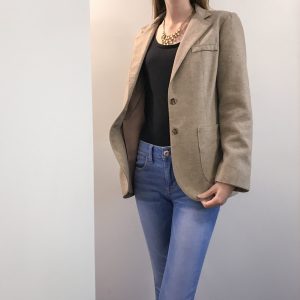
I also got this camel-coloured blazer. I can’t tell if it looks too old for me or not, but I could tell that it was constructed really well. It’s tailored at the waist with vents on the back for mobility, and it’s 25% wool for some added warmth. Maybe this is the beginning of my journey to dress more like a teacher!
Brand: Plum Tree
Price: $6
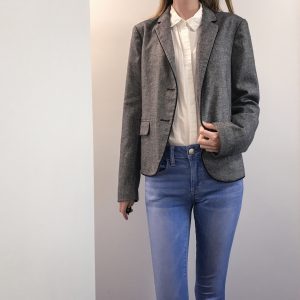
The last thing I picked up at SA was this navy blazer. You can’t see in the picture, but it has navy elbow patches which caught my eye. It’s kind of preppy and I think it’ll be nice for fall.
Brand: The Gap
Price: $6

Earlier this month, there was a bag sale at Beacon Community thrift shop. It’s a tiny store on Pandora, but they said you could fill up a bag for $8.50, so of course I had to go! This isn’t a colour I’d usually wear, but it’s 100% cotton and I just thought it was cute. It reminds me a bit of what Sandy wore in Grease when she was still a goody two shoes.
Brand: Brandy Melville
Price: Approximately $1
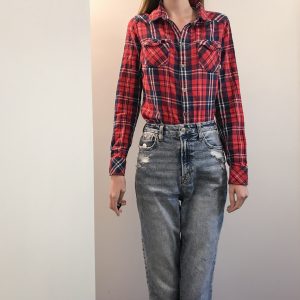
In the bag sale, I also got this plaid flannel shirt. Of course these are a fall classic! It was exactly my size and from a decent brand so I picked it up.
Brand: TNA
Price: Approximately $1
I hope it was fun and interesting to take a look at some gems that I was able to thrift. Thrifting isn’t easy; you have to search through racks of old-lady clothing, as well as old, faded, stretched out, stained, pilled items that are priced at like $10 (why???). You need a fair bit of spare time in order to properly look through all the sections: I recommend at least 30 minutes. More importantly, you need to pay attention to sales and go early in the morning (it really motivates me to get out of bed!). However, there’s absolutely no reason why you can’t dress like a queen when you shop secondhand. You can find popular brands, luxurious fabrics, vintage pieces, and one-of-a-kind items. For anyone concerned about the environment and the ethics of fast fashion, I recommend thrifting – it’s an adventure you won’t regret!

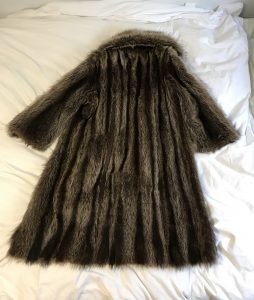

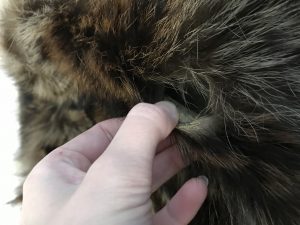
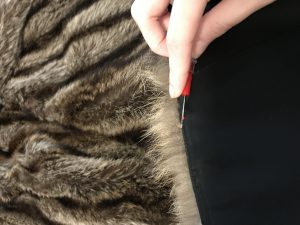
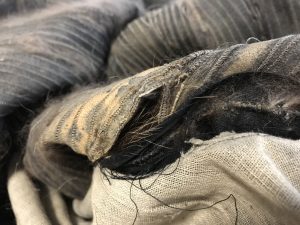
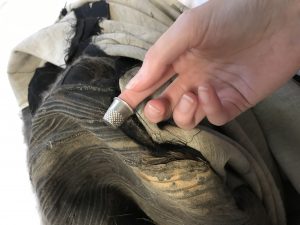

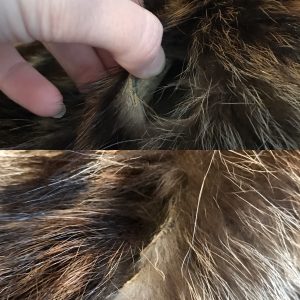


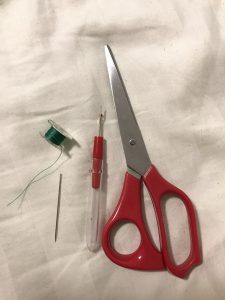

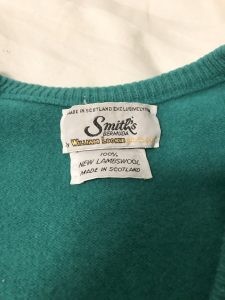
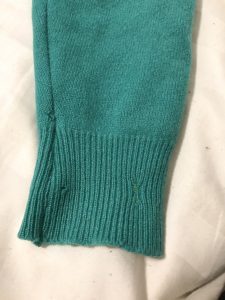
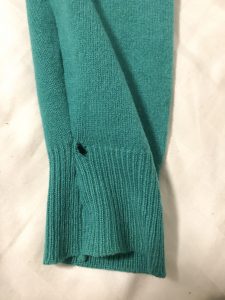

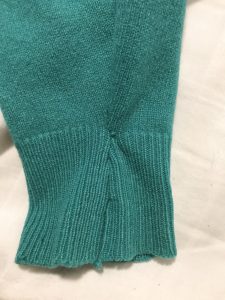
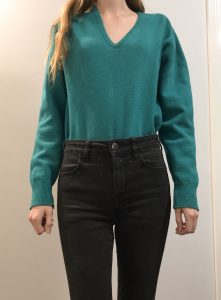











Recent Comments